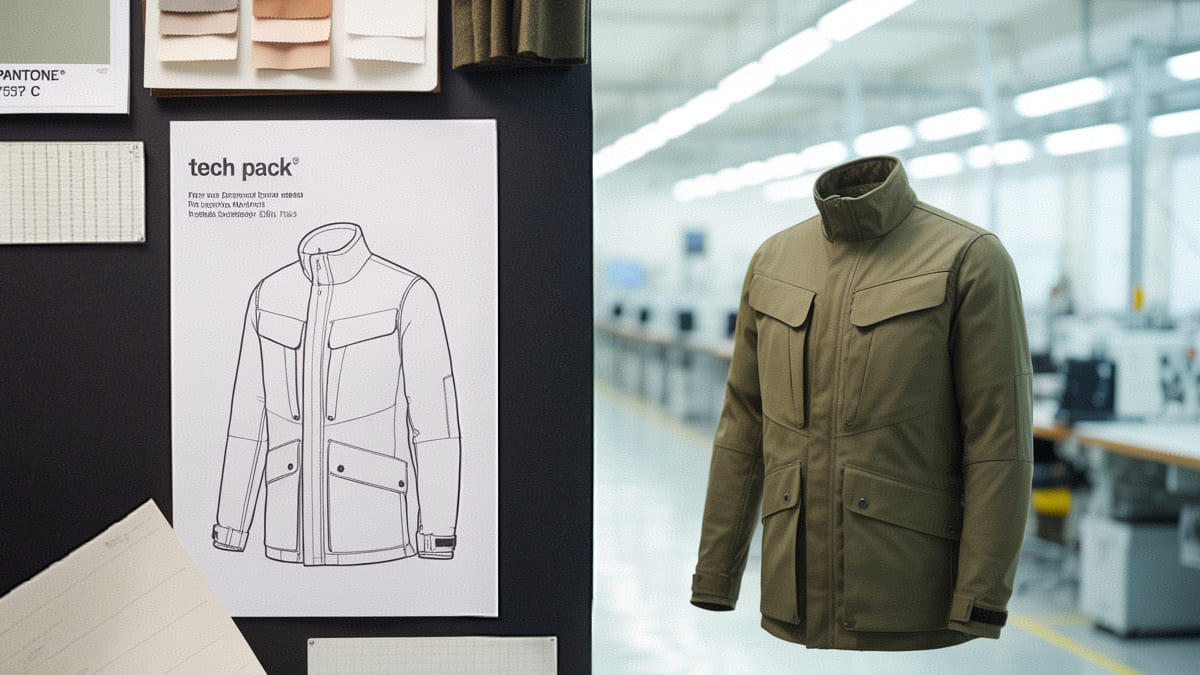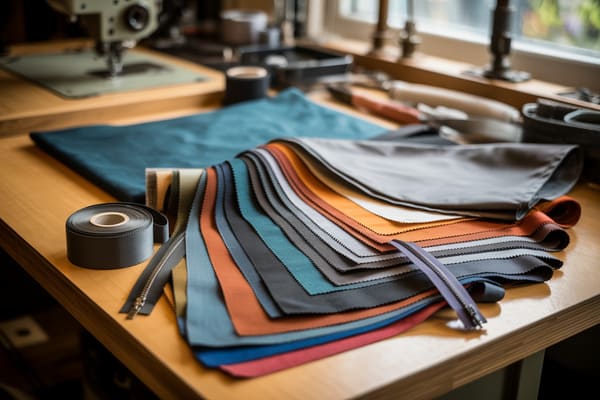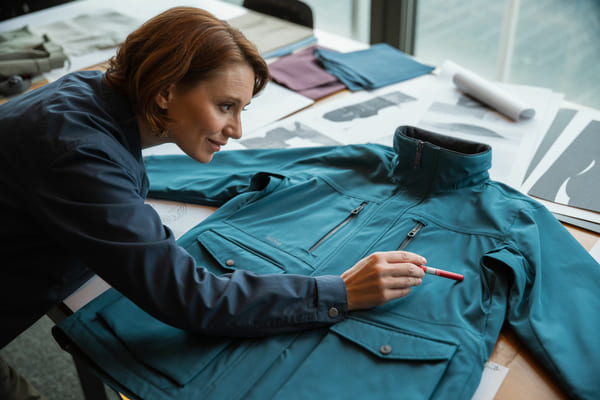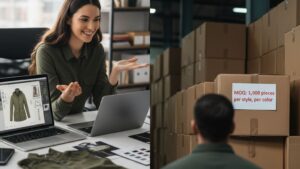From Prototype to Production: Accelerating Your Hunting Gear Development

📌 Table of Contents
You’ve got a killer idea for a piece of hunting gear. A jacket that’s lighter, a pack that’s smarter, a base layer that breathes better. But I’ve seen it a hundred times: that brilliant spark gets bogged down in the long, dark tunnel of development. Months turn into a year, seasons are missed, and your cash flow dwindles.
To accelerate hunting gear development from prototype to production, you must master five key areas: create a hyper-detailed Tech Pack, source materials strategically by leveraging your manufacturer’s network, engage in a responsive and collaborative prototyping process, maintain crystal-clear communication, and integrate testing and quality control from day one.
This isn’t just theory. This is the roadmap I’ve built over 15 years on the factory floor. If you’re tired of watching your vision crawl towards the finish line, read on. We’re about to put a turbocharger on your development engine.
The High Cost of Slow: Why Speed is Your Secret Weapon
Let’s get one thing straight: in the modern outdoor market, speed isn’t just a "nice to have"—it’s a matter of survival. The landscape is littered with brands that had great ideas but were simply too slow to execute. As a manufacturing partner, I see the financial and strategic damage firsthand.
Missing the Season, Missing the Market
The hunting world operates on a strict seasonal calendar. A delay of just 6-8 weeks can mean your new whitetail jacket, originally planned for an August launch, doesn’t hit shelves until October. By then, your target customers have already bought their gear for the season. You’ve not only lost a year of revenue, but you’ve also given your competitors a free pass to capture that market share.
This isn’t just about one product. The global hunting apparel market is incredibly dynamic, with consumers constantly seeking the latest innovations in materials and design 1. If you’re launching last year’s technology, you’re already behind. Speed to market allows you to be the innovator, not the follower.
The Cash Flow Killer
For any brand, but especially for startups and small businesses, cash is oxygen. A slow development cycle is a slow-motion suffocation. Every month spent tweaking prototypes, waiting for fabric samples, or clarifying miscommunications is another month you’re burning through capital without generating revenue.
Think about it:
- Longer R&D Cycles: More designer hours, more sample costs, more shipping fees.
- Tied-Up Capital: Money is sunk into development that could be used for marketing, inventory, or hiring.
- Delayed ROI: The longer it takes to launch, the longer it takes to start recouping your investment.
A streamlined, accelerated development process plugs these leaks, keeping your business financially healthy and poised for growth. It transforms your manufacturing from a cost center into a strategic asset.
The Blueprint: Your Tech Pack is Your Bible
If you want to go fast, you need a map. In apparel manufacturing, that map is the Technical Pack, or "Tech Pack."
I cannot overstate this: a detailed, professional tech pack is the single most important document you will create. It is the universal language that translates your design vision into a physical product. Sending a manufacturer a simple sketch and saying "make this" is a recipe for disaster, delays, and endless, costly revisions.

A tech pack is a comprehensive blueprint that leaves nothing to interpretation. It tells the pattern maker, the sample sewer, and the production manager exactly what to do. A good one, like those we insist on at Hi-nect, contains several critical components 2.
Key Components of a World-Class Tech Pack
-
Cover Page & Summary: A quick overview of the product, including the style name/number, season, a brief description, and a flat sketch of the front and back.
-
Technical Flats (CADs): These are detailed, to-scale black-and-white drawings of your garment. They must show every seam, stitch line, pocket, zipper, and piece of hardware. Callouts with arrows should point to specific details and explain them. For example: "5mm wide double-needle topstitch" or "YKK AquaGuard #5 zipper."
-
Bill of Materials (BOM): Think of this as the ingredient list for your product. It itemizes every single component required.
- Main Fabric: e.g., "3-Layer Hardshell, 70D Nylon Face, ePTFE Membrane, 20D Tricot Backer."
- Contrast Fabric: e.g., "Schoeller-Dynamic stretch panels for underarms."
- Pocket Lining: e.g., "Brushed mesh, 120gsm."
- Zippers: Specify brand, model, size, and color (e.g., "YKK #5 Vislon, main opening, color-matched to fabric").
- Threads: Specify material and weight.
- Labels: Main brand label, care label, size label.
- Hardware: Snaps, cord locks, pullers, eyelets.
-
Graded Measurement Specification Sheet ("Graded Spec"): This is the heart of the fit. It provides the key measurements for your sample size (e.g., Large). It then shows how those measurements "grade" up or down for all other sizes (XS, S, M, L, XL, XXL). This ensures consistent fit across your entire size range. Measurements include things like chest width, body length, sleeve length, and cuff opening.
-
Construction Details: This is where you get granular. It can be a dedicated page or callouts on your technical flats.
- Stitches Per Inch (SPI): Different seams require different SPI for strength and appearance.
- Seam Types: Is it a flat-felled seam for durability on a pant inseam? Or a simple overlock on a lining?
- Seam Sealing: Specify the width of the seam tape (e.g., "18mm 3-layer seam tape on all critical seams").
- Bar Tacks: Show exactly where to place bar tacks for reinforcement (e.g., at pocket corners, belt loops).
-
Colorways & Artwork: This page shows each color combination you plan to produce. It should specify Pantone (PMS) colors for fabrics and trims to ensure accuracy. If there’s a logo, this is where you specify its size, placement (e.g., "3cm from left chest seam, 5cm from shoulder seam"), and application method (e.g., embroidery, heat transfer, screen print).
Investing the time to create a thorough tech pack upfront will save you ten times that amount of time on the back end. It is the single biggest accelerator in the entire development process because it eliminates the #1 cause of delays: ambiguity.
The Engine Room: Sourcing Materials Strategically
Your gear is only as good as the materials it’s made from. But sourcing those materials—the fabrics, membranes, zippers, and trims—can be a labyrinth that grinds your timeline to a halt.
The traditional approach is slow: a brand spends weeks or months finding fabric suppliers, requesting samples, and negotiating terms, all before they even approach a garment manufacturer. This is inefficient. The secret to accelerating sourcing is to leverage the expertise and network of your manufacturing partner 3.
Let Your Manufacturer Be Your Sourcing Agent
A top-tier OEM/ODM partner like Hi-nect isn’t just a sewing factory; we are a supply chain hub. We have long-standing relationships with dozens of world-class mills and trim suppliers. When you partner with us, you get instant access to that network.
Instead of you cold-calling YKK, we can get their latest catalog and samples on your desk in days because we place huge orders with them every year. Instead of you searching for a specific 3-layer waterproof-breathable fabric, we can present you with options from three different trusted mills that we know can deliver on quality and on time.
This collaborative approach turns weeks of frustrating research into a few productive meetings.

In-Stock vs. Custom: A Smart Trade-Off
- In-Stock Materials: These are fabrics and trims that a mill or your manufacturer keeps on hand.
- Pro: Extremely fast. You can get samples and production yardage almost immediately.
- Con: Less unique. Other brands may be using the same materials.
- Custom Materials: This involves developing a fabric exclusively for your brand, with a custom weave, weight, or color.
- Pro: 100% unique to your brand, giving you a competitive edge.
- Con: Very slow and expensive. It can take 3-6 months just to develop and produce the fabric, and MOQs are high.
The Acceleration Strategy: For new brands or new product lines, I always recommend a hybrid approach. Use high-quality, in-stock fabrics from your manufacturer’s library for the first one or two seasons. This allows you to get to market fast. Once you have established sales and a better understanding of your customer, you can then invest in developing a custom fabric for your V2.0 product.
Don’t Get Caught in the "Trim Trap"
I’ve seen multi-million dollar productions delayed for weeks over a 10-cent cord lock. It sounds crazy, but it happens all the time. Brands focus 99% of their attention on the main fabric and forget about the trims: zippers, snaps, buttons, pullers, labels, and drawcords.
A custom-colored zipper pull from YKK can have a 60-day lead time. If you only realize you need it when the jackets are ready to be sewn, your entire production line grinds to a halt.
The Acceleration Strategy: Finalize your trims at the same time as your main fabric. Your BOM in the tech pack should be 100% complete before you approve the first prototype. A good manufacturing partner will force this discipline, ordering all long-lead-time components well in advance so they arrive at the factory at the same time as the fabric.
The Litmus Test: Prototyping That Doesn’t Drag
Prototyping is where your idea becomes tangible. It’s also where timelines go to die. I call it the "prototype spiral"—that endless cycle of samples, feedback, revisions, and waiting that can stretch on for months.
Accelerating this stage isn’t about skipping steps; it’s about making each step more efficient and purposeful.
Understanding the Sample Types
First, let’s clarify what we’re making. There isn’t just one "prototype." There are several key stages:
- Fit Sample: The very first version. The goal here is 90% focused on fit, pattern, and construction. It’s often made in a stock color. Is the articulation right? Is the length correct? Are the pockets placed ergonomically?
- Salesman Sample (SMS) / Photo Sample: This is the "looks-like" version. It’s made with the correct fabrics, colors, and trims. This is the sample you’ll use for marketing photoshoots and to show to retail buyers. The fit should be 95% finalized here.
- Pre-Production Sample (PPS): This is the final, "golden" sample. It is made on the actual production line with the final production materials. When you approve this sample, you are giving the green light to produce thousands of them. It must be perfect.
The Secrets to a Faster Sample Process
- A Great Tech Pack: We’ve already covered this, but it’s worth repeating. A detailed tech pack can help you get a 90% correct Fit Sample on the very first try, potentially eliminating an entire round of revisions.
- A Partner with In-House Expertise: Does your manufacturer have their own pattern makers and sample room? At Hi-nect, we do 4. This means we can get feedback on a Friday, have our pattern maker adjust the digital pattern over the weekend, and cut a new sample on Monday. Factories that outsource pattern-making add days or weeks to this cycle.
- Provide Crystal-Clear Feedback: This is your responsibility as the brand. "The fit is weird" is not helpful feedback. "The sleeve is 2cm too long, and the chest circumference needs to be increased by 1.5cm to accommodate a mid-layer" is perfect feedback.
- Use photos. Put the sample on a fit model.
- Mark up the photos with arrows and notes.
- Reference the spec sheet in your comments.
- Consolidate all feedback into a single, organized document. Don’t send five separate emails.

A responsive prototyping process is a conversation between you and your manufacturer. The faster and clearer that conversation is, the faster you’ll get to an approved design.
The Human Element: Communication is the Ultimate Accelerator
You can have the best tech pack and the fastest sample room in the world, but if your communication is poor, your project will stall. This "soft skill" is the lubricant for the entire development engine.
Partnership Over Transaction
The biggest mistake I see brands make is treating their manufacturer like a vending machine. They put in a tech pack and expect a perfect product to come out. It doesn’t work that way.
The fastest brands view us as a partner. They are transparent about their goals, their budget, and their concerns. In return, we are transparent about production realities, potential risks, and opportunities for improvement.
A transactional relationship is reactive. A partnership is proactive. I’ll often call a client and say, "I know your tech pack specifies this type of seam, but for this lightweight fabric, I recommend a different construction that will be stronger and look cleaner. Can I send you a sample of what I mean?" That five-minute conversation can save a week of revisions and result in a better product.
The Power of a Single Point of Contact
When you’re working with a factory, are you talking to a salesperson, a project manager, or a random person in the sample room? Being passed around is a massive time-waster.
A key feature of an efficient manufacturing partner is a dedicated project manager or merchandiser 5. This person is your single point of contact. They understand your brand, they know the status of your project, and they can communicate your needs directly to the pattern makers, sourcing team, and production floor. This structure prevents things from getting lost in translation and provides clear accountability.
Overcoming the Time Zone and Language Gap
Working with an overseas partner means dealing with time zones and potential language barriers. This can be a source of delay if not managed properly.
- Schedule Overlap: Find a partner who is willing to schedule calls during a time that overlaps with your workday, even if it’s early or late for them.
- Visual Communication: Use photos, videos, and sketches whenever possible. A picture truly is worth a thousand words, especially when bridging a language gap.
- Confirm in Writing: After a call, send a brief email summarizing the key decisions and action items. This ensures everyone is on the same page.
A great partner works to make these challenges invisible. Their communication is so clear and responsive that it feels like they’re in the office next door.
Crossing the Finish Line: From Approval to Production
You’ve approved the PPS. The hard part is over, right? Not quite. The transition from a single approved sample to a full production run is a critical stage where new delays can emerge if not managed carefully.
The Pre-Production Meeting
Before a single piece is cut for the bulk order, a pre-production meeting should occur. This involves your project manager, the head of the sewing line, and the quality control manager. They review the approved PPS and the tech pack one last time. This meeting ensures that the knowledge from the sample room is successfully transferred to the bulk production team. It’s a final check to catch any potential misunderstandings before they are multiplied by a thousand.
Inline Quality Control (QC)
Many brands think of QC as something that happens at the very end—inspecting the finished goods before they ship. This is a huge mistake. By then, if there’s a problem, it’s too late. The entire order might have the same defect.
The Acceleration Strategy: Insist on inline QC. This means quality checks are performed throughout the production process, not just at the end.
- Check 1: Fabric Inspection: All fabric is checked for defects before it’s cut.
- Check 2: Cut Panel Inspection: Panels are checked for accuracy against the patterns.
- Check 3: Early-Stage Assembly: The first 50-100 units are pulled from the line and inspected. Is the collar set correctly? Is the zipper inserted properly? This early feedback allows for adjustments before the full run is completed.
- Check 4: Final Inspection: A final random sampling of finished, packed goods is performed based on AQL (Acceptable Quality Limit) standards.
This multi-stage approach prevents catastrophic errors, eliminates the need for mass re-works (a massive time-killer), and ensures the product that ships is the product you approved.
Your Roadmap to Faster Development
Getting your hunting gear from a brilliant idea to a best-selling product doesn’t have to be a slow, painful journey. By focusing on the right things, you can build a development process that is a competitive advantage, not a bottleneck.
Let’s recap the blueprint:
- Build a Flawless Blueprint: Invest heavily in a detailed, professional Tech Pack. It is the foundation of speed.
- Source Strategically: Don’t go it alone. Leverage your manufacturing partner’s network and make smart trade-offs between in-stock and custom materials.
- Prototype with Purpose: Understand the different sample stages and provide crystal-clear, consolidated feedback to minimize revisions.
- Communicate Like a Partner: Ditch the transactional mindset. Build a transparent, proactive relationship with your manufacturer.
- Integrate Quality from the Start: Use inline QC to catch problems early and ensure a smooth transition to bulk production.
This is the system we’ve perfected at Hi-nect. It’s how we help brands launch innovative products faster and more efficiently than their competition.
What is the single biggest bottleneck you face in your current development process? Answering that question is the first step on your new, accelerated path to market.
References
[1] Fortune Business Insights: Hunting Apparel Market Size, Share & COVID-19 Impact Analysis 1
[2] MakersRow: Why a Tech Pack is Vital to Production 2
[3] Hi-nect: Your Expert Hunting Apparel Manufacturer & Development Partner
[4] Hi-nect: About Us
[5] Hi-nect: What Company Makes The Best Hunting Clothes?
Ready to elevate your outdoor apparel line?
Let’s talk. We offer flexible MOQ, fast samples, and expert guidance — get your quote today.
You may also be interested in:

A Hunter's Guide to Waterproof & Breathable Fabric Science
Introduction For any serious hunter, the right apparel is not a luxury; it is a critical piece of equipment that

Lowering MOQs: A Guide for Hunting & Outdoor Brands
You’ve done it. After countless late nights, sketches on napkins, and heated debates over fabric textures, you’ve perfected the design

Top 13 Hunting Apparel Manufacturers 2025
I’ve been in the performance apparel industry for over 15 years, and let me tell you, choosing the right hunting
